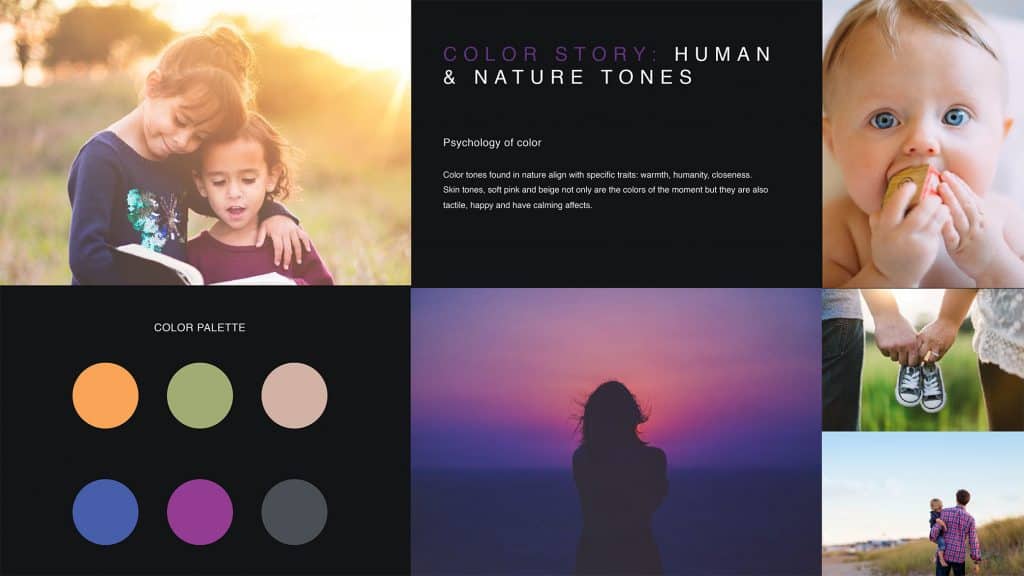One of the most important parts of your brand identity is choosing a color palette for your brand. In fact, research has shown that up to 84.7 percent of customers cite color as the primary reason they make buying decisions.
Your brand colors affect how your customers perceive your brand, and they create a cohesive look between all of your marketing materials, from your website to your brochures.
But how do you choose the best colors for your brand? Here’s a simple 7 step process to get you started in choosing a color palette for your brand.
Step 1: Know color psychology (and its limitations)
When choosing a palette for your brand, it’s helpful to know a bit about color psychology and the meanings of the different colors. I delved deep into this topic in my last post.
Knowing about color psychology will help you choose colors based on their universal attributes.
Choosing a color palette for your brand: The limitations of “color meanings”
However, before you begin choosing a color palette for your brand based solely on these meanings, consider this: it’s far more important that your colors fit your brand than that they fit into the universal meanings attributed to them.
Color meanings are different to each person because everyone has different experiences. They’re also variable based on your culture.
If you’re still not convinced, here’s a great YouTube video that explains why it’s so important to choose colors because of their brand fit rather than their universal meaning: Personality Before Color
Step 2: Research your competitors
Before moving forward with choosing a color palette for your brand, take time to research some of the other providers in your industry.
What are the most common brand colors? Intentionally choose different colors for your brand so that you stand out in the marketplace.
For example, if you have an organic food company, you might gravitate towards green, because it’s often associated with organic foods and health. However, many of your competitors are probably using green for those very same reason. In that case, you would be wise to instead choose a different color so that your brand stands out in your niche.
Step 3: Use your mood board for inspiration.
Your brand colors should be chosen based on a longer branding process that takes into account your values, brand story, and your target audience. Part of the process of crafting a brand identity is making a mood board to represent your brand. Use your mood board to help you create a color palette that makes sense for your brand.
Adobe Color CC is an amazing tool that will allow you to import a photo or a screenshot of your moodboard and pick out the colors based on different types of palettes.
You can choose between bright, muted, deep, dark, and custom palettes. For the custom palette, move color selectors around on your mood board or photo until you get a color palette you like. If you want to save your color palette in Adobe, you’ll need to sign in or create an account. Click the color wheel icon on the top right, and you’ll see the HEX codes of the colors you’ve chosen.

NOTE: A HEX code is a 6 digit code, made up of letters and numbers, that identifies colors. You can enter it into any publishing or photo editing program to use specific colors. You will also need the HEX codes of your color palette to use the colors on your website.
ColorZilla is a Chrome and Firefox extension that lets you pick out any color in your browser with an eyedropper. It then gives you the HEX code for the color.
Step 4: Intentionally create color combinations
There are different types of color combinations, and you may want to use a mix of them when are choosing a color palette for your brand.
Colors are made up of the following components:
Hue – What we think of as color, i.e. purple, red, green, etc.
Value – The amount of white or black in the color. Colors of a higher value are lighter and colors of a lower value are darker.
Tint – Tints are colors that have white added to them.
Shades – Shades are colors that have black added to them.
Chroma – The amount of saturation in the color. When colors are more saturated, they appear more vivid. When they’re less saturated, they appear more washed out.
Complementary colors
Complementary colors are across from each other on the color wheel. For example, green and red are complementary colors and blue and orange are complementary colors.
Pros: Complementary colors contrast with each other, so it’s easy to make some of your design elements stand out.
Cons: You have to be careful when choosing colors from across the color wheel, as they may clash.
Analogous colors
Analogous colors are on the same side of the color wheel, so they’re either all cool colors (blue, purple, and green) or all warm colors (red, orange, and yellow.)
Pros: When you choose an analogous color scheme, the colors will naturally be harmonious and won’t clash with each other.
Cons: It can be difficult to create enough variety in an analogous color palette to make it interesting. That’s why it’s so important to use different values and chromas within your color scheme.

Monochromatic colors
Monochromatic colors are different shades or tints of the same hue.
Pros: A monochromatic color scheme can help your brand become associated with one specific hue. Pairing a few monochromatic colors with one contrasting color will help elements of your branding stand out.
Cons: Monochromatic color schemes can be boring if you don’t choose a wide enough variety of tints and shades.
Step 5: Choose colors that serve different functions.

While you’ll most likely have a palette of 2-6 colors, not all of your colors will serve the same function. Keep that in mind when choosing a color palette for your brand.
Dominant brand colors
You’ll have two dominant brand colors, which you’ll use for your logo. These are the colors your brand will become known for. (Examples: Target red, McDonalds yellow, Starbucks green.)
You can only have one or two dominant colors, and they should be distinctive. For example, Target copyrighted their red color so that no one else in their industry could use it.
A call to action color
The point of a call to action color is for people to see it and take some kind of action, whether that’s calling you, clicking “Buy Now,” or scheduling an appointment to come see you.
You want your call to action color to stand out from your dominant colors so that it’s easy for people to see it. If you’ve chosen a monochromatic or analogous palette, consider choosing a complementary color that pops out from the others for your call to action color.
Neutral colors
The last 2 colors in your color palette should be neutral. Choose a lighter color, like white or ivory, for your background color. Then pick a dark color, like black or dark gray, for your text.
Step 6: Test out your color palette
Formerly known as Adobe Kuler, Adobe Color is a go-to tool to choosing a color palette for your brand. This online platform offers a range of features to create, explore, and save color palettes. You can choose from various color rules and modes, extract palettes from images, and even upload your own creations. With Adobe Color, you’ll discover harmonious color combinations that make your projects pop.
Colormind takes color exploration to the next level with its AI-powered color palette generator. By utilizing deep learning algorithms, Colormind creates harmonious color combinations based on your preferences. It offers options to generate palettes from uploaded images or manually select colors. Colormind’s smart suggestions can provide valuable insights when you’re stuck on finding the perfect palette.
Step 7: Save your color palette
Once you’ve finished choosing a color palette for your brand, create a document with your colors, their HEX codes, and how you intend to use them on your website and other marketing materials. This will help you easily find and use the HEX codes later on.
To sum up choosing a color palette for your brand
It takes time to find the perfect color palette for your brand. Use these steps to do so:
-
- Understand color psychology
- Know your competitors
- Use your mood board for inspiration
- Intentionally create color combinations
- Choose colors that serve different functions
- Test out your color palette
- Save your color palette
If you’re a newbie to design, I hope you learned a lot about choosing a color palette for your brand. If you’re a designer or creative director, do you have any other tips for choosing brand colors? I’d love to hear from you!
Crème de Mint has specialized in beauty, food and supplement packaging design for more than 15 years. Our CPG branding agency knows how to create compelling, craveworthy designs that can help your brand stand out! Book a call today to chat with us about your packaging design.


